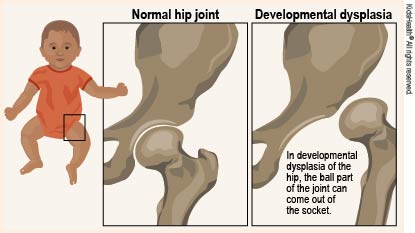Developmental dysplasia of the hip (DDH) is a problem with the way a baby's hip joint forms. The hip socket where the top of the leg should fit is shallow and the top of the leg may be completely, or partly, out of the socket. Sometimes the problem starts before the baby is born, and sometimes it happens after birth, as the child grows.
Developmental dysplasia of the hip is treated by an orthopedic (bone specialist) team. Your child is being treated with a type of brace called a Pavlik harness. The Pavlik harness is a soft brace made of fabric that holds the top of the legs inside the hip socket so the hip joint can develop normally. Most babies need to wear the harness for 6–12 weeks.

Follow the orthopedic team's instructions for:
- When your baby needs to wear the harness. At first, your baby needs to wear the harness almost all of the time. After a few weeks, your baby might need to wear it only at night.
- Whether it's OK to take the harness off for bathing. If your baby needs to keep the harness on, give a sponge bath so you don't get the harness wet. To give a sponge bath:
- Wet a sponge or washcloth with warm water and a little fragrance-free, gentle soap and wring until just damp.
- Starting with the face (avoid the eyes) and working down to the feet, wipe the skin with the sponge or washcloth. Take special care to avoid the harness.
- Rinse the sponge or washcloth with plain, warm water and wring until just damp. Wipe the skin again to remove any soap.
- Dry the skin with a clean towel.
- Any exercises your baby should do (such as tummy time) and how to do them.
- What to do if the harness gets dirty.
- When you should follow up. While wearing the harness, your baby will need to be seen by the orthopedic team often to check that the hips are in position and if the harness needs an adjustment.
Other instructions:
- Do not adjust the straps of the harness unless someone on the orthopedic team tells you to.
- To care for your baby's skin:
- Keep their skin clean and dry.
- Pay close attention to the areas where the legs meet the body and behind the knees. To keep these areas dry, wipe them with a dry cloth at each diaper change.
- Do not use lotions, powders, or creams under the harness.
- Change diapers often so the harness doesn't get wet or soiled.
- To change your baby's diaper:
- Use leak-proof, disposable diapers.
- Lift your baby up from under the lower back to remove and replace the diaper.
- Don't lift your baby by the feet to change the diaper.
- Make sure the straps in the back of the harness aren't caught in the diaper.
- To dress your baby:
- Do not remove the harness to dress your baby. Put your baby's clothing on over the harness.
- Use one size larger, if needed.
- One-piece outfits with snaps work well.
- Safety
- Buckle your baby safely in the car seat appropriate for their age and size.
- Continue to put your baby to sleep on their back, in a crib or bassinette with no pillows, bumpers, toys, or blankets.

Your baby has skin redness or rubbing from the harness.

What happens if developmental dysplasia of the hip isn't treated? Without treatment, the hip joint will not grow normally. The top of the leg may not fit into the hip socket. This can lead to limping, uneven leg lengths, and hip arthritis at a young age.
What if the harness doesn't treat my baby's developmental dysplasia of the hip? The harness usually works well; most babies won't need other treatment. If other treatment is needed, the orthopedic surgeon may recommend surgery and a cast.
What problems can happen from the Pavlik harness? The most common problem is skin irritation. Rarely, more serious problems can happen, such as loss of blood supply to the bone (called avascular necrosis) or nerve damage. Follow your orthopedic team's instructions to help prevent these problems.
Can developmental dysplasia of the hip run in families? Yes. The health care provider may recommend testing any children you have in the future. If they have developmental dysplasia of the hip, treatment can start right away.




